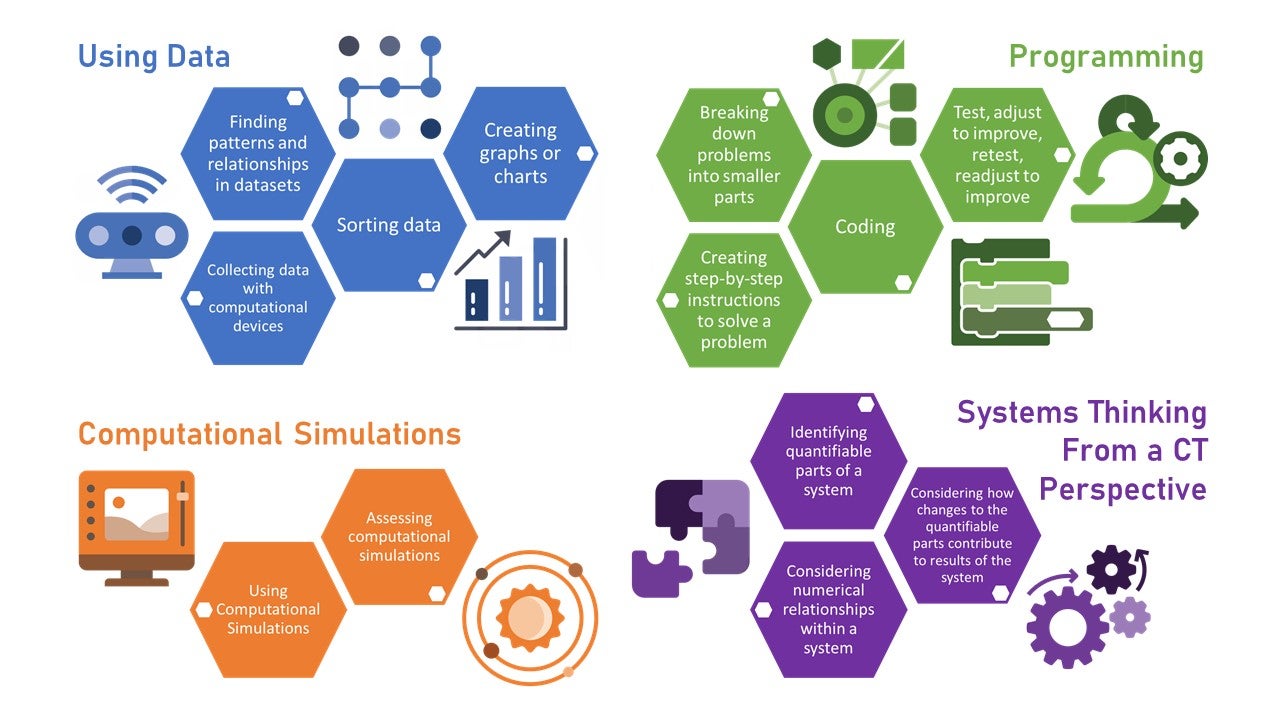STIGCT: The Science Teaching Computational Thinking Inquiry Group
A Community of Practice-Based Professional Development around CT Integrated Science Lessons for Pre-Service and In-Service teachers
Merijke Coenraad, Jandelyn Plane, Diane Jass Ketelhut, Lautaro Cabrera, Kelly Mills, and Heather Killen
Over the course of two years, our team of computer science, elementary science, and teacher educators partnered with more than 50 pre-service and in-service teachers to design, develop, and implement The Science Teaching Computational Thinking Inquiry Group (STIGCT) using Design Based Research. Through two iterations, we identified best practices and key activities for professional development (PD) that support teachers to integrate computational thinking (CT) into elementary science lessons. In this guide, we provide activities used within our STIGCT PD and the rationale behind each activity. In the second year of STIGCT, when teachers went through these activities, over 80% of teachers successfully wrote and enacted a CT integrated science lesson for their elementary classroom.
Broadly, STIGCT aims to support the development of CT integrated science experiences. It has four goals:
-
creating a community of teachers interested in CT,
-
providing PD about CT content, tool, and pedagogy to support integration,
-
building upon teachers’ existing knowledge,
-
scaffolding teachers’ design of integrated lesson plans for their classrooms.
Participants: Working toward these goals, STIGCT brings together pre-service and in-service teachers with university researchers to work together and develop a community of practice. Many of the pre-service and in-service teachers were partnered as mentor teachers and pre-service student teachers within their classrooms, but this was not a requirement and un-partnered pre-service and in-service teachers participated.
Prior CT Knowledge: Since the focus of our professional development was CT integration, all participants had prior knowledge of CT. This was ensured by our team collaborating with instructors of the pre-service science methods course (pre-service teachers) and hosting a starter course covering the corresponding material before STIGCT began for in-service teachers (see our forthcoming guide on Integrating CT into Elementary Science Methods Teacher Education Course).
Session Structure: Each STIGCT session was based on one CT Practice (see Framework section below) and was divided into three parts: a presentation of the CT practice, participating in CT infused science activities from a student lens, and co-designing the beginning of a lesson plan, a “lesson seed,” with grade-similar pre-service and in-service teachers and at least one facilitator.

We found it was essential to provide teachers with not only knowledge of CT and examples of CT, but specific practice in integrating CT into the science classroom and examples of this integration. We also found that the lesson seed planning time where teachers and facilitators co-design CT integrated science lessons provided an optimal opportunity for both generating lesson plans and assessing teachers’ CT knowledge in order to correct misconceptions.
Timeframe: STIGCT met monthly for four months in the Spring semester. Each meeting was 3 hours. The spring semester was chosen so that pre-service teachers could finish their elementary science methods course, held in the Fall, where CT was integrated into the activities and be in their full-time student teaching placement.
Framework (Ketelhut et al., 2019): We used a framework for CT in elementary science specifically designed by our team. While we used a combination of a previously published framework and definition in the first year, we found that it was not specific enough to teachers’ elementary science context. Our resulting framework is based on the work of Weintrop et al. (2016), but specifically focuses on the elementary school context. For more information on the framework, see “Our Framework” .

Framework Citation: Ketelhut, D. J., Cabrera, L., McGinnis, R. J., Plane, J., Coenraad, M., Killen, H., & Mills, K. M. (2019). Exploring the Integration of computational Thinking into Preservice Elementary Science Teacher Education. National Science Foundation STEM+C PI Meeting. http://stemcsummit.edc.org/slides/DianeJass.pdf
Within this guide, you will find an overview of the goals and activities from STIGCT. For each activity, there is a detailed description of how to run the activity, required materials, the rationale behind including that activity in STIGCT, and our tips for success and future considerations. We hope the guide provides you with resources to support teachers as they integrate CT into elementary science. You can explore the guide through this website by clicking the STIG Overview tab or download the STIG Guide Full PDF.
| Main Topic | Goals | Activities |
|---|---|---|
|
Programming Practices |
|
1. CT Vignette |
|
Data Practices |
|
1. CT Vignette 2. Weather Fronts Breakout Rooms a. Weather Fronts Breakout b. Scratch for Weather c. Weather Sensing micro:bits 2. Lesson Seed Co-Design |
|
Systems Thinking through Computational Simulations |
|
1. CT Vignette 2. Tinkering with Examples of Modules/Simulations 3. Grade Specific Simulations 4. Stories from the Field: Lesson Plan Sharing 5. Lesson Seed Co-Design |
|
CT Integrated Science Lesson Plans |
|
1. CT Vignette 2. Stories from the Field: Lesson Plan Sharing 3. Reflection and Discussion |
| Additional Resources |
Unplugged activities to provide additional computational thinking for students. When working with teachers, be sure to use these in conjunction with other activities and make explicit connections between the computing content and science integration. |
1. Human Robot Activity 2. Synthesize a Story Jigsaw 3. Systems Thinking Challenge Stations 4. What’s My Mystery STEM Career |
Access the STIG Guide Full PDF here.
Suggested Citation: Coenraad, M., Plane, J., Ketelhut, D.J., Cabrera, L., Mills, K., Killen, H. (2020). STIGCT: The Science Teacher Computational Thinking Inquiry Group. Retrieved from https://education.umd.edu/stigct

This material is based upon work supported by the National Science Foundation under Grant No. 1639891.